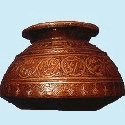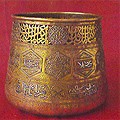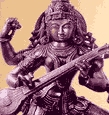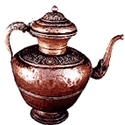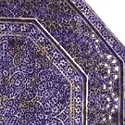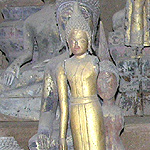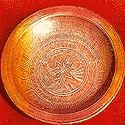High-quality silver work is done in Rajasthan. The products made are spice boxes, rose-water sprinklers, caskets and hukkas, all elaborately ornamented with bird and animal figures. Highly-carved silver furniture, like bed-legs, divan-legs, and swings with links having bird designs, is also found here. Etching on metal is found in temple decorations like the chauki which is the platform on which the deity is placed. This has a decorative screen with traceries behind it and the chatra, a plate edged with floral carvings, is hung with strings as the covering for the image. Kalsha is another ornamented decoration kept in the corners of the chauki or on the palanquin. The other items which are highly carved are crowns, canopies, umbrellas, and seats. Chasing, a technique where light-impression designs are done on the metal surface is practised widely in Rajasthan. In this technique a blunt chisel is used and only trace imprints of the design are done on the metal surface. This artwork is said to be a variation of bidri, and is done on plain or gilded brass and copper vessels where the floral ornamentation in relief is created by chasing or punching away the background around the relief work. The chased areas are filled with black lac which is fused to the surface. The floral designs glitter against a black background. This form of work is locally called marori. When the pattern is black and the background is in copper or brass, then the work is called chrakwan. In Jaipur, both forms are practised and the lac used is in a variety of colours. Jaipur, Jodhpur, and Udaipur are the main centres. Jaipur is also known for its engraved, lacquered or enamelled brassware, which is mainly used for decorative purposes. Jodhpur is the main centre for handcrafted iron. It is also known for its aluminium shields and trophies. Koftagiri is found mainly in Jaipur, Ajmer, and Pushkar and is practised by very few artisans. This is the technique where light-coloured metal is inlaid on a darker surface. It was used originally for weapons and arms. A lac surface is fixed on the metal (usually iron) and after drawing the design with a chisel it is inlaid with gold and silver threads. The metal surface gets a blue-black gloss after the application of a mixture of lime juice and sand mixture. Brassware which is chased, engraved, enamelled, lacquered, and encrusted is a speciality of Jaipur. A wide range of items, including vases, perforated lamps, table tops, fruit bowls, planters, jewellery boxes, and picture frames can be found. These are embellished with engraved motifs like flowers, landscapes, jungle scenes, and geometrical patterns. The engraving is done in three styles: chikan, a motif of bold flower decoration which stands out against the chased and lacquered surface; marori, minute lacquered patterns covering the entire surface; and bidri, minute leaves and flowers in an all-over design on a chased and lacquered surface. Ink wells, pen cases, styluses, compasses, and holders are the outstanding brass, iron, or silver items found in Rajasthan. The ink wells are in simple circular, square, or octagonal shapes, while the small opening at the top is often more ornate. This metal ware is mainly found in the towns of Udaipur, Jodhpur, and Ajmer, and even in smaller places like Banswara, Dungarpur, and Pratapgarh. The cire- perdue or lost wax process of metal-casting is used widely to make rural deities and votive objects. Icons of gods like Ganesha and Hanuman are made. Brass objects also include incense burners with perforated leaves, and handles in the shape of snakes, parrots, peacocks, or lotus stalks. Swings are a popular item of household furniture in Rajasthan --- the chains are made of brass. Containers for betel leaf, and areca nut and catechu, all popular items of consumption, are also made. Lime containers are made in brass and take the shape of coconuts, mangoes, melons, or the lotus. Boxes for betel leaves are perforated to allow the air to circulate and to keep the contents fresh. Hookah bases and chillums ( pipes of plain brass, copper, or silver) are made in beautiful shapes with damascening or enamel work. Metal combs with simple and elegant designs are found all over Rajasthan. Kajaldans of brass are made along with slender bottles for kohl which have mirrors attached to them. Kankavatis or containers for the red pigment used to mark the forehead are made in many interesting forms. Foot scrubbers are made with great imagination and often have metal bells sealed inside the hollow space, thus creating a rhythmic sound. The handles of the scrubbers are shaped like birds, animals, humans. Well moulded brass toys like chariots, cannons, elephants, horses, and camels are made in Jodhpur. From the sixteenth century onwards, bronzes representing Hindu deities, equestrian figurines, dipa lakshmis, and animal figurines mounted on wheels, have been cast. There are no exaggerations, distortions, or stylisations. The human figure is highly simplified and the head is much larger than the rest of the body. Single figures are common and the accent is on primary shapes. A thin flat strip of metal forms the base. Jain bronze figures continue to be made by the cire-perdue process in different parts of Rajasthan. Jewellery boxes, grain measures, scales, lotas, spouted pots, and a variety of kitchen utensils in copper, brass, and bronze show a remarkable combination of beauty and practicality.
Uttar Pradesh is the largest copper and copper-making region in India. The utensils are made at Etawah, Varanasi, and Sitapur. Ritual articles are made mainly in copper-like tamrapatras, panch patras which holds articles of worship, sinhasans which are the seats for deities, and the kanchanthals which are plates for offering flowers and sweets. Varanasi is also known for icon-casting. Art metal ware is an ancient craft of India and the Islamic influence enriched the craft further. The metal handicrafts of Moradabad exemplify this influence. Engraving, one of the earliest processes of embellishing metal ware is practised in Moradabad. Various tools such as the kalam --- a steel-pointed pencil --- are used to trace the pattern on to the brass, silver, or copper. A thappi and tipai are then used for the actual engraving. Moradabad engravers can produce extremely fine and delicate work, which is now exported the world over.
The gharua or the dhokra kumar tribes are the traditional metal workers of West Bengal. They are semi-nomadic and are related to the malhars of Bihar and the situlias of Odisha. They live in Bankura, Burdwan, Midnapore, and Purulia districts, all of which are close to the Chota Nagpur region of Bihar; the malhars live in the hills and forests. The dhokras of West Bengal, Bihar, and Odisha claim kinship with the dhokras of Madhya Pradesh. They are all part of the same tribal group of that area. Their metal ware has a strong and primitive folk style. They make small images of Goddess Lakshmi, her mount, the owl, Lord Lakshmi Narayan riding on an elephant, and Radha and Lord Krishna in different attitudes. These images are kept in the household shrines of newly married Hindu couples to bring prosperity and happiness. Decorative caskets were made and sold, as were measuring bowls that were considered as symbols of Goddess Lakshmi. Ritual lamps of different designs, small models of animals and birds, and a variety of trinkets and bells are also made. The dhokras use the lost wax process to cast hollow brass objects and images. The object of wax is modelled in detail around a hardened clay core, which has approximately the same shape of the object to be cast. Layers of soft, refractory material are laid over the wax model and hardened into a mould. The wax between the core and the inner surface of the mould is lost or burnt out as the mould is heated and the molten metal takes its place and hardens between the core and the inner surface of the mould which holds a negative impression of the wax model in all its detail. The outer surface of the hardened metal reproduces the shape and details of the original wax model with the core producing the hollow interior. The hard core and the mould become soft and spongy on firing and are easily removed. The dhokra craftspersons have a wonderful sense of shape and surface decoration. All their products are embellished with fine linear decorations which conform to the general shape of the objects. Religious images --- like Goddess Durga in her avatar of Mahishasuarmardini where she slays the bull headed demon, Mahishasura --- are cast. At Nabadwip, the old centre of Vaishnava culture some artisans families make small images of gods and goddesses, and decorative figures which are cast solid. Similar figures are made in the Chitpur and Bhawanipur areas of Calcutta. The technique used is a fine-oiled, sand casting method. The metals used are brass, copper, bronze, silver, and octo alloy (an alloy of eight metals --- gold, silver, copper, tin, nickel, zinc, lead, and iron). The traditional metal workers of West Bengal who work with copper and its alloys are known as kangsakars or kansaris. One group originates from the karmarkars or blacksmiths and the other from the pasana branch of sutradhars, the carpenter and wood-carving caste. They make articles from kansa alloy, which is seven parts of copper and one part of tin and the shapes are made by beating and hammering. Kansaris and metal workers from different caste groups specialise in mould or die casting, using the hammering process; semi-tribal dhokras never use any process other than the lost wax process. Traditional metal ware is made by casting, forging, or shaping. The metals used are copper and its alloys. For lost wax casting and die casting, brass and bronze are generally used. An alloy of 70 per cent copper and 30 per cent zinc is considered to be the best brass. Metal craftspersons working with brass are found in most districts of West Bengal with local variations. The kangsakars, bell-metal artisans make their wares from the kansa alloy. Ritual ware is made from copper sheets, eating utensils are made of kansa, and utensils for cooking are cast in brass or shaped in sheet brass, copper, or iron. The seven to one alloy used in Bengal does not tarnish and is resistant to mild acids, but it is not malleable enough for easy working. Kangsa artisans work in groups of five and plates, bowls or tumblers are forged from lumps of kansa on anvils and steel shapers in a cycle of heating and hammering. The lumps of metal take the desired shapes and are finished on indigenous, hand-operated lathes. Die cast utensils use three moulds --- one for the core and two for the outer shape. Sheet metal utensils are made by beating the sheets to the required shape on anvils and shapers. Elaborate shapes are made by dovetailing the parts and welding them together by heating and hammering. Surface decoration is rare in the utensils of West Bengal but very intricate workmanship is found in the repoussé ornamented pieces of Kansaripada of Bhawanipur in Calcutta. All the utensils have simple but well-balanced shapes suited to their purpose. The products made are beautifully shaped and decorated caskets, platters, cups, bowls, and other items in silver, brass, and copper. At Suri in Birbhum district, wooden bowls are embellished with sheet metal decorations, which are traditionally made in different sizes for different measures of rice were extensively used by rich farmers; Each utensil centre has its own well-known design like the beautiful chakaibati of Tamluk, chamby ghati and phero of Kangra and the different designs of the kalshis of Vishnupur. The products are divided into five groups: thalas or plates; batis or bowls; gelas or tumblers; ghatis or drinking pots; and kalshis or pitchers for storing water. The kalshis or pitchers are shaped in three to four pieces and welded together in the indigenous method. Ghatis or drinking pots and tumblers are shaped in one piece. They are all traditional Vishnupur designs. Adibasis, santhals, or mundaris of the Chota Nagpur hill areas of Bihar and the western districts of West Bengal never use cast metal utensils. They use a large beautifully proportioned heavy metal bowl known as jambati, a heavy and deep platter for eating and drinking purposes, earthen pots, and beaten brass and iron utensils for cooking, drinking, and water storage. Cast brass household utensils consist of cooking pots, bowls, storage pots, and a variety of interestingly shaped dishes and caskets for carrying and offering paan (areca nut and betel leaf combination).
An indigenous tradition of metal-crafts has existed in Pakistam since time immemorial. The use of copper and its alloys by the Indus Valley culture is proved by the discovery of numerous well-made utensils at Mohenjo Daro and Harappa. Not only were metals and alloys used to make implements like axes, hooks, chisels, etc., and utensils, like pots, salvers, and goblets, the technique of casting sculptural figures also was known. The eight-inch statuette described as the Mohenjo Daro dancing girl and the fragment of a foot with anklet - both in bronze - continue to be mentioned as outstanding examples of Indus Valley metal-craft in all studies of ancient art.
Delhi is an old centre for metal work. Generations of metal workers practice their skill here. This craft has been handed down in families and survives mainly in the narrow lanes of the old city of Delhi especially in Galli Dhobiyan Bazaar and Dilli Gate.
Though brass, copper and silver sheets are all used in crafting the articles it is mainly brass that continues to be used. Sketches of the objects are first made on paper and then transferred on to the metal sheets. All the products are almost entirely handmade, the metal being beaten into shape with a hammer. The turning process is done on a hand-lathe and the soldering requires a metal alloy, which is prepared by the artisans. The base and the body of the vessel are made separately and then soldered together. The soldered joints are beaten with a hammer and the surface is scraped. The object is frequently heated in the furnace to keep the metal soft; it is also repeatedly beaten with a mogri, wooden hammer, in order to remove all the dents and smoothen the surface. Before engraving a mixture of lac, gum made from rice, powdered brick and mustard oil is made and heated until a gelatinous solution is obtained. This thick paste is poured onto the metal object and allowed to solidify for 5 to 6 hours. The thick solidified solution creates a barrier that ensures that the utensil does not get punctured by the chisels and hammers during the engraving process. After engraving the object is heated and the lac dissolved and removed. Some experts also additionally perforate the metal so that pattern for the tracery emerges.
The various tools used are also made by the metal workers themselves and include different varieties of Hathodi/hammers, Kalaam/chisels and Kattia/scissors. Only the final polishing or buffing is done by machine.
The product range includes utensils of utility and ritual use and art ware; particularly table tops, metal lamps, wall plaques and plates, planters, and hanging lamps.
The Moosaries, the community of traditional metal workers create idols of various Brahmanical deities for temples and homes in Kerala. Casting in bronze or a combination of bronze and brass they use the lost wax process/cire perdue. The icons follow strictly the iconographic and iconometric rules as laid down by the canonical text, the Shipla Shastra ; where the system of measurement is based on the unit as the tala, the distance between the hairline and the end of the lower jaw. The process begins with the preparation of a mixture of pure beeswax, resin from a tree and groundnut oil. Using a spatula, knife, and scraper, this substance is fashioned into the pattern; the head, body and limbs are thus individually fashioned and joined. Wax cross strappings and runners are then affixed at appropriate locations to strengthen the wax pattern as well as to facilitate the flow of molten metal into various parts. The surface of this model is now coated with layers of various clays to form a completed mould containing within it the original wax pattern. This is heated in an open ground oven fuelled by cow dung cakes so that the molten wax drains out through the runner. An alloy of copper, brass and lead is made; the lead grants malleability thus facilitating the chiseling and engraving of the icon while the brass is added to the copper to lower the melting point of the alloy and to add and enduring luster to the finished product. This molten alloy is carefully poured into a previously heated mould; once cooled the mould is broken and the details of the idol are engraved. The metal surface is smoothed with fine grade emery paper and cleaned with a solution of tamarind and soap nut; and finally, the piece is brushed with polishing sand and water. Bronze rafter shoes are a peculiarity of Kerala. These are used to protect the outer ends of rafters The craftsmen for bronze casting can be found in Payyanur, Korom, Thayineri, Padoli, Kunhimangalam in Kannur district; in Kasaragod; Thiruvananthpuram; Nadavaramba, Kurmamkulam , Kadavallur in Thrissur district and in Mannapra, Kannambra, Nenmara, Alathur and Angadipuram in Palakkad district. Kerala is also known for its distinctive bell metal metal lamps which are free standing and portable, ceremonial as well as for domestic use; these are cast using the lost wax technique. Often the lamps that are multi-tiered and floor-standing are embellished with a garuda, swan, or peacock, or else with the figure of a god or goddess and are classified according to the motifs they bear - the deepalaxmi shaped in form of a graceful lady holding a lamp, mitevilakku with its distinct peacock pattern, the hamsavilakku resembling the swan and the vimanavilakku shaped like a tower and connected by a chain, the changalavattu or the peacock lamp with the animal's body serving as a reservoir for oil and the tail as the handle that is now used for processions in temples but was initially held before the old rulers and aristocrats when they went out in procession; Teertavalli the lamp with a yoni or vulva like receptacle and a spout; Armapakshi named after the motif of the bird of abundance ; Kurishivilakku - lamp with stylized Christian cross (kurushi) ; Nagaradhanuvilakku - snake shaped lamp ; Kuttavilakku - lamp for temple procession ; Tookavilakku hanging lamp; Koddivilakku - lamp to light the temple lamp; Tiripazhadakacheri - lamp that has spouts for wicks ; Kadaplave - lamp shape based on the small jackfruit . Hanging lamps in various sizes, oil lamps, and changalavattas or the Greek lamp are highly sought after. The beautiful lamps which are made for the prayer rooms and temples are known as nelavilakku and thookuvilakku. Those pertaining to the temple are the archanadeepa or votive lamp, the aratideepa or prayer lamp; and the deepastambha or pillar lamp that is used at the entrance of the sanctum; tiripazhadakacheri or the small lamp with five spouts for the wicks, a kavaravilakku or lamp with three receptacles; the vilakku or ceremonial lamp, usually of cast bell metal is used in homes as well as temples; they may be lit before and image of a deity as guests, or used to signify the presence of the fire god Agni. Kurmimangalam traditional lamp Some lamps made for the temple courtyard are over 5 feet high and appear to be simultaneously ornate and austere: they have plain smooth lines as well as a series of circular recesses to hold oil and wicks. Other items include jugs, tumblers, paan boxes, and lime jars of many varieties. The chilambu are hollow cast and contain small metal balls that create a rattling noise when the ornament is shaken; Karpooratatta - vessel used to burn camphor; Dhoopakal - vessel for buring incense and domestic utensils like Appakava - vessel used for cooking urmiappam; Kollabmi – spittoon; Cooja - container used to carry milk and water and the Kindi - vessel to pour water. Trivandrum, Irinjalkuda, Trichur, and Kasaragod are the main bell-metal centers. Koftagiri, the inlay of a light-coloured metal on a darker metal surface resembles damascene and was popularly used for weapons and arms. In this process a lac surface is fixed on the metal and after drawing the design with a chisel it is inlaid with gold and silver threads. The metal surface gets a blue-black gloss after application of lime juice and a sand mixture. Utilitarian and decorative articles are made with this technique which is practised in Kerala by the metal artisans.
Manipur is known for its gold and gold-plated jewellery. Beautifully designed old jewellery can be seen on display in the state museum. Some of this is being reproduced in silver.
Lucknow is well know for its Kamdani and Fardi ka kaam or metal work embroidery. In Kaamdani flat silver, copper and gold metal wires are used for making embroidery on thin fabrics. On the other hand, in fardi the same metal wires are used to create silver and golden dots on the fabric. Craft items created by artisans are dupattas, scarves and schiffon saris. Tools used by the crafts people in this process are needle, cowrie shell for burnishing, porcupine quill or siyahi ka kaanta and butter paper stencil.
Metal work in Kangra is carried out chiefly for creating statues and relief panels, ritual objects, bells and utensils for religious purposes in the monastery. Dharamshala is the key region for the production of these works. Tools such as chisels, files, punches and hammer are used for production process.
Himachal Pradesh is a treasure house of metal idols enshrined in temples, villages, and home altars. Traditionally, good craftsmanship grew around temples and palaces. The metals mainly used in Himachal Pradesh are brass, copper, iron, tin, and bell-metal; the various techniques practised include chasing, repoussè, engraving, casting, beating, hammering, and soldering. Repoussè, known locally as tapai, involves raising designs in relief on a metal sheet. Highly-skilled blacksmiths can be found in Chamba town, Brahmour, and Chatrahi in Chamba district and in Kangra, Kulu, and Kinnaur districts. Metal idols of gods in the classical as well as rural traditions were cast by the lost wax process and both solid and hollow methods of casting were used. Traditionally an alloy of five metals ---gold, silver, copper, brass, and lead --- was used to cast bronze images, but in contemporary times an alloy of brass, copper, and lead is used. Ritual objects for temples and house altars include octagonal low settees, bells with decorative handles, incense burners, lamps, jars for storing ganga jal, flasks for storing wine, and umbrella-like canopies in silver and brass. The silver filigree work practised in Mandi shows remarkable skill and delicacy. The metalsmiths of Kinnaur make door handles in the form of a crocodile, tiger, or lion head using the repoussè technique.
In Jammu and Kashmir, the Fateh Kandal area is known for copper vessels. Milk containers and cooking pots are made here along with ladles with long handles, samovars for tea, hukka bases, water jugs or aftabas, and ornamented glasses. The artisans are known for their excellent craftsmanship. The Buddhist blacksmith community of Ladakh is involved in brass and iron work; one of the main items being made are the kitchen stoves called thap chabrik. Attractively ornamented locks and keys are also made. In a village called Chilling in the Zanskar area of Ladakh, silver, brass, and copper is found in abundance. Silver engraving is done to embellish the products made here. Tea kettles, lids for tea bowls, and copper ladles are also made by the silversmiths or sergars. The copper and brass prayer wheels embellished with silver are made by sergars, who also fashion cooking vessels, water jugs, tea pots, chhang pots, bowls, ladles, and tea bowl covers. In Ladakh, the blacksmith community of gara makes iron stoves, locks, keys, and conch bangles. The iron stoves are elaborately decorated with brass strips cut into traditional designs of religious and auspicious significance. These blacksmiths also move from house to house with their tools, repairing old metal objects or galvanising them, and installing large iron stoves, complete with ovens, grills, and ashtrays, with brass ornamentation. They also manufacture agricultural implements and uniquely designed locks. Decorative designs commonly used by the gara include dragons facing each other, druk khabrel, floral strips, and tanka similar to those found on old Chinese coins. Jammu's most typical and traditional metal craft is the casting of large vessels especially those used for cooking during weddings and other festive occasions. Copper still remains the most popular metal for household use in Kashmir and the most common items are the lota, samovar, and tram. Kashmir also has some beautiful silver work with patterns like the chinar and lotus leaf. The production of a silver object involves three stages --- preparation, engraving and cleaning, and finally, gilding. The different people involved in the various production processes are the khar or smith, naqash or engraver, zarcob or gilder, roshangar or polisher and charakgar or cleaner. In Kashmir, enamelling is done on silver, copper, and brass by fusing various mineral substances.
Metalworkers have always enjoyed a special status among the craft communities as the taboos, rites and rituals associated with metal are many. In most traditional communities it is usually the men who work with fire and metals.
- Black smithing and iron forging. The Kui and several of the Bahnaric-speaking people were once famous for iron forging. The craft had its origin in black smithing. This skill is now being utilized for the manufacture of iron products.
- Casting and forging of various musical instruments including the following:
- Bronze drums
- Gongs
- Cymbals
- Metal-bar instruments
- Casting of Buddha images
- Jewelry and Silverware
In Manipur metal-casting is still a cottage industry and localised in the areas close to Imphal. Bell-metal, locally known as senjeng, is an important metal not only for manufacture of household utensils but for objects of art as well. Metal products of Manipur have their own distinct shapes and derive much of their aesthetic vitality from the ancient lost wax hollow casting technique by which they are made. Beside bell-metal the other metals used are brass, copper, and bronze. The wax image into which the molten metal is placed is kept in a clay mould. Krishna Kanti, a special item, is a large bowl with a broad encircling rim at the neck on a small pedestal. Ceremonial items like the sengabetel nut container and a large-sized bell with the image of Garuda at the top are also popular. Plain metal bowls as well as those with surface decoration are in constant demand.
Metal craft is restricted to selected families and is practised by the menfolk. The khasis, known for their proficiency with metal and have been involved in extracting iron ore, manufacturing domestic knives and utensils, and even guns and other weapons using metal. The other articles made by these tribes are agricultural implements like the axe, the sickle, and hoe.
Enameling or minakari can be described as the art of coloring and ornamenting the surface of metals by fusing over it brilliant colors that are patterned in an intricate design. Enamel or mina work was a notable Mughal innovation in metal craft. Mina was popular both with the Mughals and the Hindu princes of Rajasthan where it was used for enriching jewelry and for creating other precious objects.
Using a variety of colors the craftspersons ornament the surface of the metal. Gold has traditionally been used for minakari jewelry as its luster brings out the colors of the enamels; it also holds the enamel better and lasts longer. Silver is a later introduction and is used for artifacts like boxes, bowls, spoons, and art pieces. Copper, which is used for handicraft products, was introduced only after the Gold Control Act --- which compelled the minakars to look for a material other than gold --- was enforced in India.
The work of the minakar often went unnoticed as, traditionally, minakari patterns were used basically as a backing for the famous kundan or stone-studded jewellery. Several reasons were cited to explain this: the prosaic explanation was that it allowed the wearer to reverse the jewellery, while the more poetic reason was that the wearer of the jewellery was promised a special joy in the secret of the hidden design!
The minakars belong to the Sonar or Soni caste of kshatriyas and identify themselves with the name of Minakar or Verma. This is a hereditary craft and the minakars seldom allow outsiders to acquire any knowledge of their craft. The process followed is long and complex and a single piece of mina can pass through many hands before it is completed. The traditional sequence starts with the designer (nacquash, chitera), and moves on to the goldsmith (sonar, swarnakar), the engraver who engraves the design (kalamkar, khodnakar), the enamellist who applies the colour (minakar), the polisher (ghotnawala, chiknawala), the stone-setter (jadia, kundansaaz), and the stringer (patua), all of whom are part of the chain that creates the finished product. However, often a single artisan performs a multiplicity of tasks.
Like a miniature artist, the minakar engraves the surface of the metal with intricate designs using a metal stylus. This is then filled in with colors. When placed in a furnace, the colors fuse and harden to become one with the surface. The piece is then gently rubbed with a file and cleaned with a mixture of lemon and tamarind, which helps emphasize the brilliance of each color. Enamel colors are metal oxides mixed with a frit of finely powdered glass; the shade obtained varies according to the amount of oxide added and the powder is suspended in water for ease of application. The color yellow is obtained through the use of chromate of potash, violet through carbonate of manganese, blue through cobalt oxide, green through copper oxide, brown through red oxide, and black through manganese, iron, and cobalt. The brilliant red is the most difficult of colors to achieve. White and ivory, also difficult, are achieved through a mix of antinomies of potash, hydrated iron oxide, and carbonate of zinc. The minakar applies the color according to their level of hardness, beginning with the hardest. Before the enamel is applied the surface of the ornament is carefully cleaned. In their raw form these mixtures do not always show their true colors, which emerge only when they are fired in the kiln. The average firing temperature is about 850 degrees Celsius. The enamel colors are bought either from Amritsar in Punjab or from Germany or France.
Enameling was earlier practiced in many centers in India, with each region specializing in its own variation of style and technique. In Lucknow the speciality of the minakars was blue and green enamelling on silver, while in Banaras the dusky rose-pink or the gulabi mina was the dominant colour. The craft was also practised in Kangra, Kashmir, and Bhawalpur. It was, however, most vibrant in Jaipur (Rajasthan) and in Delhi, and these two centres continue to create minakari pieces of excellence till today.
The family members of Ram Krishan Minakar, a master craftsman and a National Award winner based in Delhi state that the craft of minakari has been handed down for at least four generations, if not longer. The children, too, are interested in following the family tradition. Ram Krishan's family today works with a copper and brass alloy to make handicraft items that are sold all over the country and even exported. They are one of the few minakar families who work with this alloy. They traditionally worked with gold till the Gold Control Act was introduced in India and it became hard if not impossible to access Gold, through design innovation and adapting of technique the family honed this new technique. The mix of the alloy is a closely guarded family secret.
In Delhi and Jaipur two forms of enamelling are popular: the champlevé style where the metal is engraved to create depressions into which colour is embedded; and the repoussé form in which a thin metal plate is embossed over a prefabricated die. This die has the design etched on one of its sides. The metal plate is moulded over the die by stamping on it. Once this is done the grooves are etched with the help of a metal stylus and the colours filled into the areas created. A metal stylus with its front flattened and shaped like a wedge is used for carving and engraving the base metal. The mina is powdered before use with a grinder and is dispersed with a metal spatula into the palette. Long pointed needles of different thicknesses are used for applying the colour on the carved or moulded metal plate. Blocks are used both for engraving and for embossing the metal plate. The kiln is an essential part of the process and can range from a relatively modern to a homemade one. Tools for the final cleaning of the piece include an iron needle and a file. The design vocabulary in minakari is vast and includes many patterns. Creepers and vines, flowers (particularly the lotus), birds (especially the parrot and the peacock), paisleys, geometric patterns, and calligraphy are some of the more commonly used designs. The colours used are red, green, white, and blue.
In its contemporary form, minakari is not confined to traditional jewellery but ranges into more 'modern' products, often with a copper base, including bowls, ashtrays, key chains, vases, spoons, figures of deities, and wall pieces.

